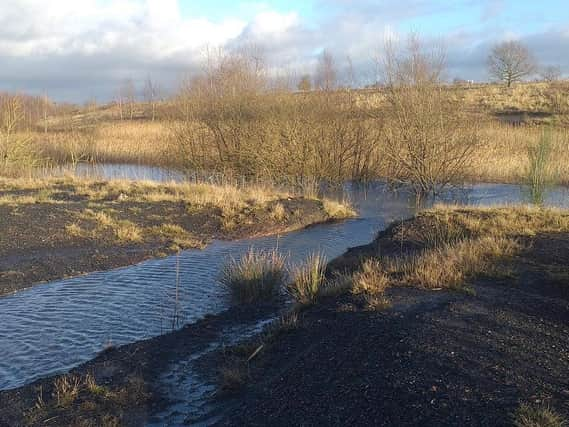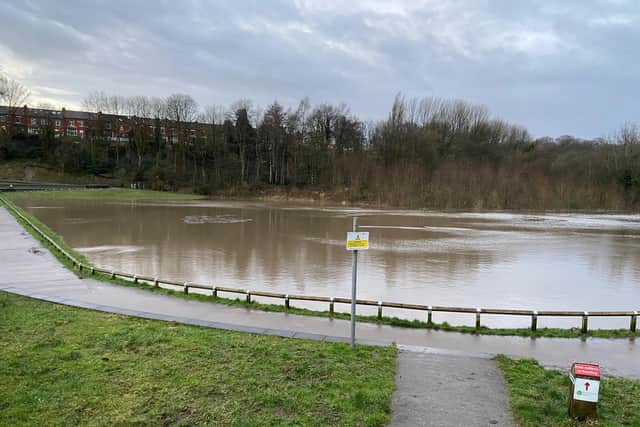How Wigan's nature reserves are sparing our homes from flooding


Bickershaw, Lightshaw Meadows and Wigan Flashes, all in Wigan, Lunt Meadows at Crosby and Brockholes Nature Reserve at Preston have been managed to create areas where floodwater can run, before reaching residential areas.
And while this may cause some disruption to wildlife, things get back to normal fairly quickly according to the Wildlife Trust for Lancashire, Manchester and North Merseyside.
Advertisement
Hide AdAdvertisement
Hide AdThe Bickershaw Nature Reserve, along with the Lightshaw Meadows, filled up with water in its floodwater storage area, preventing major damage to more than 100 properties on the Common Lane Brook area of Westleigh.


The Wildlife Trust’s Wigan Projects Manager Mark Champion said: “Overall, there was around 50 hectares of wetland which is able to store hundreds of thousands of cubed metres of water. It is fabulous to see Bickershaw doing its job of slowing the flow and water storage.
“It will be interesting to follow the story on, to look at how the site and surrounding areas cope with these deluges, like Storm Christophe, in the future.”
Bickershaw’s flood management was designed and implemented by Wigan Council, the Environment Agency and the Wildlife Trust, which manages the site.
Advertisement
Hide AdAdvertisement
Hide AdIn past week, serious breaches of the banks of the River Alt saw thousands of gallons of water flooding into the Lunt Meadows Nature Reserve in Merseyside. The water levels rose so high that parts of the car park were flooded, but it stood firm and prevented major problems in nearby Sefton and Maghull.
Lunt Meadows has been designed to act as both a flood reservoir and a nature reserve, providing wetland habitats for species, such as water vole, marsh harrier and kingfisher, while also holding excess rain and river water. The water is then either absorbed by plants and soils, returns to the atmosphere or is slowly released back into the River Alt, taking the pressure off drains and reducing the likelihood of flooding in more built-up, urban areas.
Recent work at Bickershaw in Wigan has created a water storage pool on the site, reducing local flood risks, similarly to Lunt Meadows.
During this storm, the embankment separating Lunt Meadows from the River Alt was badly damaged by the pressure of the water as it poured over into the reserve. Paths are submerged, and the water remains very deep on site, with only the tops of some bird screens visible. Nevertheless, the wildlife is still at home on site, with barn owls spotted hunting of an evening, hundreds of lapwing displaying and greylag geese swimming across the fields in which they normally graze in the day.
Advertisement
Hide AdAdvertisement
Hide AdThe Wildlife Trust’s Lunt Meadow’s Project Manager Cheryl Ashton said: “We are working closely with the Environment Agency to get the site open but while the reserve remains flooded and inaccessible, we don’t yet know the extent of any damage, and therefore the best approach to fix any issues.
The water is slowly retreating and the wildlife is still present, but we have got to be patient and only open up again when it is safe.
“This event shows the importance of Lunt Meadows in the local area. Not only is it a brilliant site for wildlife – it is proving vital in protecting local communities from severe weather events. Every town needs a Lunt Meadows.”
Other Wildlife Trust reserves have been designed to act as flood plains, keeping damaging amounts of water away from towns and villages.
Advertisement
Hide AdAdvertisement
Hide AdThe iconic floating Brockholes Visitor Village rises with the water from the River Ribble when it is flood. The reserve closes on a few occasions when water levels get too high, but it is just doing its job.
Areas of peat around Manchester and North Lancashire and on the moors, soak up rain water, slowing the flow of any floodwater.
Wildlife Trust Campaigns Manager Alan Wright said: “This is why these areas are so carefully managed to hold vast amounts of water and prevent problems spreading to homes. If you need evidence of how things can go wrong you only need to look at the moors where there are areas that are deliberately kept too dry. When it rains heavily the water runs off the moors into rivers and floods towns and villages.
“We are really proud of the work that has been done at Lunt, Bickershaw and Brockholes because it has prevented many thousands of people having to deal with the misery of their homes being flooded.
Advertisement
Hide AdAdvertisement
Hide Ad“While rising water levels are not always ideal for wildlife, once the waters slip back nature just gets on with life. We have designed these habitats to allow that to happen.”
Alan stressed that nature reserves would re-open when they are safe. He said: “We would ask people to be patient and not travel to these reserves until we have the all clear. Just remember they are protecting people’s homes and the wildlife will be there when you return.”
Coppull Mill dam was created several years ago to prevent flooding in several parts of Wigan and has saved properties on numerous occasions since. The unblocking of drains in the Springfield area, previously clogged with dead leaves and other refuse, has also served to prevent local homes from being flooded during and after heavy downpours.
Anyone keen to visit their local nature reserve during lockdown should consult the website www.lancswt.org.uk or www.brockholes.org or check local media to see if they are open.
Advertisement
Hide AdAdvertisement
Hide AdThe Wildlife Trust for Lancashire, Manchester and North Merseyside is dedicated to the protection and promotion of the wildlife in Lancashire, seven boroughs of Greater Manchester and four of Merseyside, all lying north of the River Mersey. It manages around 40 nature reserves and 20 Local Nature Reserves covering acres of woodland, wetland, upland and meadow.
The Trust has 30,000 members, and over 1,200 volunteers.
The Wigan Observer and Wigan Post are more reliant than ever on your taking out a digital subscription to support our journalism. For unlimited access to Wigan news and information online, you can subscribe at www.wigantoday.net/subscriptions